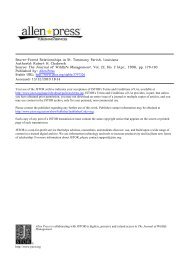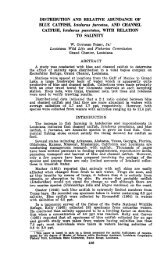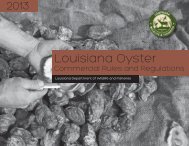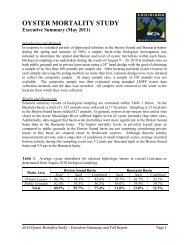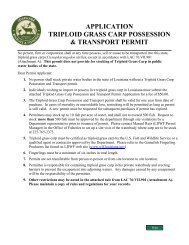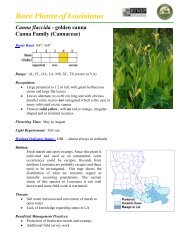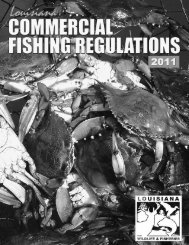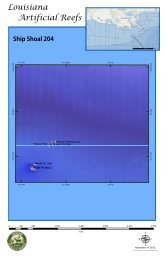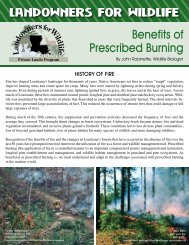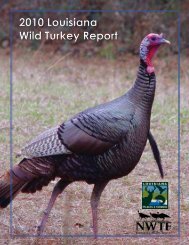11. Coastal Live Oak-Hackberry Forest - Louisiana Department of ...
11. Coastal Live Oak-Hackberry Forest - Louisiana Department of ...
11. Coastal Live Oak-Hackberry Forest - Louisiana Department of ...
You also want an ePaper? Increase the reach of your titles
YUMPU automatically turns print PDFs into web optimized ePapers that Google loves.
CONSERVATION HABITATS & SPECIES ASSESSMENTS LA CWCS--DEC 20052. Work with landowners to initiate or continue the implementation <strong>of</strong> PIF birdconservation plans, conservation plans developed for amphibians and reptiles, andUSFWS endangered and threatened species recovery plans over the next 10 years.3. Determine the microhabitat preferences and requirements <strong>of</strong> species utilizing<strong>Coastal</strong> <strong>Live</strong> <strong>Oak</strong>-<strong>Hackberry</strong> <strong>Forest</strong> to understand how these species are utilizing thehabitat and to determine management needs.Threats Affecting Habitat:The following table illustrates the threats identified for this habitat type and the sources<strong>of</strong> these threats. This represents all threats and sources <strong>of</strong> threats identified across allecoregions <strong>of</strong> the state where this habitat occurs.ThreatSource <strong>of</strong> ThreatAlteredComposition/StructureHabitatDestructionorConversionHabitatDisturbanceHabitatFragmentationDevelopment/maintenance<strong>of</strong> pipelines, roads orutilitiesXXXGrazing practices XXX XXXInvasive/alien speciesXXXMining practicesXXXResidential development XXX XXX XXXShoreline erosionXXXHabitat Conservation Strategies:1. Work with the legislature to provide incentives (tax breaks, etc.) to landowners toretain the natural state <strong>of</strong> areas where this habitat occurs.2. Partner with state and federal agencies, NGOs, private landowners, etc. to increaseconservation efforts <strong>of</strong> cheniers.3. Work with COE and NRCS to develop better strategies for the placement <strong>of</strong> dredgematerials as a restoration method for this habitat type.4. Provide educational information on this habitat type and its importance to species <strong>of</strong>conservation concern to landowners/land managers through technical pamplets andthe LDWF website.5. Review Texas tax exemption policies regarding livestock. Determine which <strong>of</strong> thesepolicies may apply to conservation <strong>of</strong> cheniers in <strong>Louisiana</strong>, and work with thelegislature to incorporate these policies into the tax code.6. Support NRCS and LDNR efforts for shoreline stabilization and habitat restoration.7. Support public acquisition/protection <strong>of</strong> high quality cheniers that have the potentialfor longterm sustainability.100
CONSERVATION HABITATS & SPECIES ASSESSMENTS LA CWCS--DEC 20058. Develop methods to encourage landowners to remove cattle from cheniers andmanage the land for wildlife conservation.9. Work with LCA, CWPPRA to broaden the coastal restoration projects to includecheniers.10. Work with appropriate planning commissions to provide LNHP data that illustrateslocations <strong>of</strong> this habitat type.<strong>11.</strong> Provide information to landowners about incentive programs/cost share opportunitiesto control invasives.References:LNHP. 1986-2004. The natural communities <strong>of</strong> <strong>Louisiana</strong>. <strong>Louisiana</strong> Natural HeritageProgram, <strong>Louisiana</strong> <strong>Department</strong> <strong>of</strong> Wildlife and Fisheries, Baton Rouge, LA.LORENZ, N. F., AND S. A. HEMMERLING. 2004. Identification <strong>of</strong> potential habitat sites forthe ornate box turtle (Terrapene ornate), the crested caracara (Caracara cheriway), andthe burrowing owl (Athene cunicularia) using GIS capabilities. Final report. Report tothe <strong>Louisiana</strong> Natural Heritage Program, <strong>Louisiana</strong> <strong>Department</strong> <strong>of</strong> Wildlife andFisheries, Baton Rouge, LA.NATURESERVE. 2005. NatureServe Explorer: An online encyclopedia <strong>of</strong> life [webapplication]. Version 4.2. NatureServe, Arlington, Virginia. Availablehttp://www.natureserve.org/explorer. (Accessed: June 8, 2005 ).NEYLAND, R., AND H. A. MEYER. 1997. Species diversity <strong>of</strong> <strong>Louisiana</strong> chenier woodyvegetation remnants. Journal <strong>of</strong> the Torrey Botanical Society 124(3):254-261.MUELLER, A. J. 1990. An inventory <strong>of</strong> upper Texas coast woodlots, valuable migratorybird habitat. Bulletin <strong>of</strong> the Texas Ornithological Society 20(1and2):14-20.SMITH, L. M. 1993. Estimated presettlement and current acres <strong>of</strong> natural plantcommunities in <strong>Louisiana</strong>. <strong>Louisiana</strong> Natural Heritage Program, <strong>Louisiana</strong> <strong>Department</strong><strong>of</strong> Wildlife and Fisheries, Baton Rouge, LA.101



